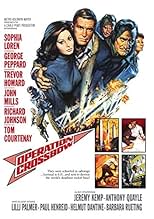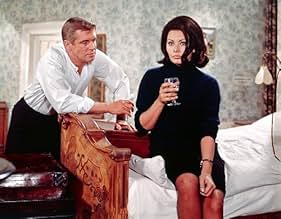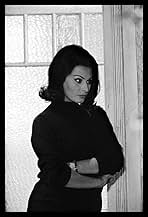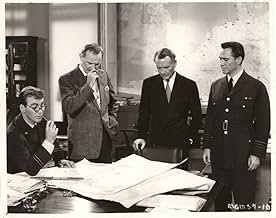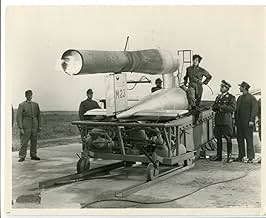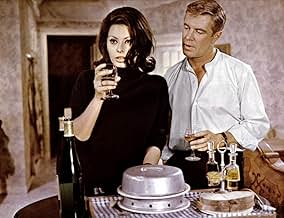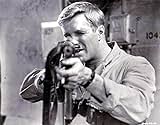IMDb RATING
6.6/10
5.9K
YOUR RATING
Allied agents attempt to infiltrate a German rocket research site.Allied agents attempt to infiltrate a German rocket research site.Allied agents attempt to infiltrate a German rocket research site.
- Awards
- 1 win total
Barbara Rütting
- Hannah Reitsch
- (as Barbara Rueting)
Featured reviews
After a pretty dull beginning, "Operation Crossbow" increases its tensions and becomes a fascinating action/adventure film set in WW2. A little-known representer of that genre, but not much inferior to "The Guns of Navarone". Lots of suspenseful moments and an interesting cast full of familiar faces.
"Operation Crossbow" was quite a hit in its day but is not seen as being in the same league as films such as "The Guns of Navarone" or "The Great Escape". Nevertheless, it is a very worthy film on many levels.
Firstly, the cast is uniformly excellent with supporting roles taken by some of Britain's acting luminaries such as Trevor Howard, John Mills and Richard Todd. The leading man is George Peppard who plays the role with his characteristically understated charm and, when called upon, a very believable physicality. Some have been critical of the fact that Sophia Loren is billed as a co-star and has very limited screen time. However, her performance as an innocent caught up in a desperate and finally unfairly cruel situation is worth watching. So too is the performance of her killer played by Lilli Palmer who embodies the emotional control, deceptiveness, resourcefulness and cool ruthlessness required by resistance contacts whose every move was potentially their last. Bouquets to Barbara Rutting who plays the real life character of Hannah Reitsch with a steely resolve and belief that had me looking up the life story of the Nazi test pilot. She remained a dedicated National Socialist until her death and was highly critical of post-war Germany and Germans. She was appalled at the fact that German soldiers by the late 60's were allowed to wear beards and that Germany was in her words now a "nation of bankers and car builders". She won many awards for her feats of aviation after the war. Other historical figures such as Constance Babington Smith, a key figure in identifying V1 rocket sites, and Professor Lindemann, who dismissed the Nazi rocket program as being a hoax, are, to my knowledge, faithfully portrayed by Sylvia Syms and Trevor Howard respectively.
The pace of the film is another highlight. The story is told through a number of points of view including the Nazi rocketry program and its own attempts at espionage and counter espionage. Almost every scene has an element of suspense - a mini story within the story. There are also some moments of humour seamlessly laced into the drama. Well done to the editor who was faced with the complex task of melding so many story elements into a very cohesive whole.
Lastly, the action scenes and in particular the final destruction of the rocket production plant is comparable to any such "destroy the villain's lair" scene including those in the Bond series. The stunts and special effects stand up very well after almost 50 years.
Firstly, the cast is uniformly excellent with supporting roles taken by some of Britain's acting luminaries such as Trevor Howard, John Mills and Richard Todd. The leading man is George Peppard who plays the role with his characteristically understated charm and, when called upon, a very believable physicality. Some have been critical of the fact that Sophia Loren is billed as a co-star and has very limited screen time. However, her performance as an innocent caught up in a desperate and finally unfairly cruel situation is worth watching. So too is the performance of her killer played by Lilli Palmer who embodies the emotional control, deceptiveness, resourcefulness and cool ruthlessness required by resistance contacts whose every move was potentially their last. Bouquets to Barbara Rutting who plays the real life character of Hannah Reitsch with a steely resolve and belief that had me looking up the life story of the Nazi test pilot. She remained a dedicated National Socialist until her death and was highly critical of post-war Germany and Germans. She was appalled at the fact that German soldiers by the late 60's were allowed to wear beards and that Germany was in her words now a "nation of bankers and car builders". She won many awards for her feats of aviation after the war. Other historical figures such as Constance Babington Smith, a key figure in identifying V1 rocket sites, and Professor Lindemann, who dismissed the Nazi rocket program as being a hoax, are, to my knowledge, faithfully portrayed by Sylvia Syms and Trevor Howard respectively.
The pace of the film is another highlight. The story is told through a number of points of view including the Nazi rocketry program and its own attempts at espionage and counter espionage. Almost every scene has an element of suspense - a mini story within the story. There are also some moments of humour seamlessly laced into the drama. Well done to the editor who was faced with the complex task of melding so many story elements into a very cohesive whole.
Lastly, the action scenes and in particular the final destruction of the rocket production plant is comparable to any such "destroy the villain's lair" scene including those in the Bond series. The stunts and special effects stand up very well after almost 50 years.
"Operation Crossbow" is a fictional movie based on historical events of World War II. It's a historical look at Hitler's program to develop rocket weapons and the Allied efforts to foil the Germans. The plot has enough intrigue and action to make the film entertaining. And, the bombing scenes keep the sense of urgency about the race between the Allies and the Germans the last two years that would determine the war's outcome.
The film has a cast of notable movie stars of the day; but I think only a couple stand out for their performances. Trevor Howard is excellent as Professor Lindemann, and Tom Courtenay is very good and convincing as Robert Henshaw.
The real pluses for this film are four. First, it's a reasonable portrayal of historical events and some key people of the time. Second, it has excellent camera work. Third, it has very good recreations of the German rockets and testing sites and of the bombing scenes in London and the air raids on the German sites. Fourth, it uses some actual war film footage sparingly.
During World War II, Operation Crossbow was the code name for the overall Allied effort to destroy the German rocket and long-range bombing projects. It began in early 1943, under the code name "Bodyline," when Allied planes photographed a V-2 rocket site in northern France. The code name changed that fall.
Some of the film characters are based on real people and use their names. Others are amalgams of people. The roles of the main stars aren't real people. Besides Winston Churchill, other British leaders portrayed were real. Richard Johnson plays Duncan Sandys who was in charge of Operation Crossbow. He had been wounded while fighting with British forces in Norway after Germany invaded that country in early 1940. He also was Churchill's son-in-law at the time.
In this movie, Sandys often is at odds with the chief science adviser to his group, Professor Lindemann. Frederick Lindemann was a real person and the chief science adviser to the British war effort. He was a close friend of Winston Churchill and made significant contributions to the Allied war efforts. But, he believed that the German rocket program was a hoax. Another leading scientific adviser was Reginald V. Jones with whom Sandys often clashed. It seems that the film writers combined the two British scientists under the character of Lindemann.
Constance Babington Smith, played by Sylvia Syms, was another very real person in the film. She was the British photo interpreter who first spotted a German rocket site from aerial photos. Another real character was Hanna Reitsch, played by Barbara Rutting. Reitsch was a renowned German aviatrix who set many flying records. She was a test pilot for the Nazis and was the only woman to receive the Iron Cross first class. She survived the war and set many glider records. Reitsch died at age 67 in August, 1979, at Frankfurt – then, West Germany.
MGM's British film group did an excellent job recreating the German Peenemünde rocket research and testing site. The filming was done along the Norfolk coast, NNE of London. Its North Sea location and coastline probably very closely resembled the real German site along the Baltic Sea.
Watching this film again, I understood how the British early on were concerned about Germany's advances in weapons. After the war, and through the 1950s, there was a general sense in the U.S. – and perhaps much of the world – that the Germans were generally superior in the fields of science and engineering. I grew up with that notion. My dad had served in the Army in Europe during WW II, and I later served in the Army in Germany during the Cold War. The Germans continued to excel in cameras, tape recorders, other electronic production and automobiles. But, with the passage of time and greater public awareness of recent history, we now know more about the seeming German prowess in the sciences.
In fact, most of technology and development of the German rocket program had been pioneered almost two decades before by an American scientist, Robert H. Goddard (1882-1945). Today, Goddard is recognized as the father of modern rocketry and the father of the space age. How ironic that when he died in 1945, many still doubted and dismissed him and his work. Yet, he had launched the world's first liquid-fueled rocket in March 1926; and he and his team had launched 34 rockets from then until 1941. He was working with grant monies and obtained more than 200 patents. But much of his work took place during the depression. And, no one – the U.S. government included, seemed interested in all the possibilities that Goddard had envisioned from rocket science and achievements.
My DVD of "Operation Crossbow" had a 10-minute short special with it, "A Look Back at Crossbow." It has some early film clips of Goddard's first attempts to launch rockets. One can see these today on YouTube. This short documentary noted that Germany collected all of the Goddard research achievements for a mere 10 cents per copy from the U.S. Patent Office. And, Adolf Hitler had his Nazi regime embark on a huge R&D program for weapons superiority shortly after he came to power in 1932. The rest is history.
Another American also had much to do with Japan's recovery after the war. W. Edwards Deming was a scientist whose work Japanese industry took seriously. In just two decades, Japan grew to become a world power based on its high quality and innovative production. Japan's industry created the Deming Prize in 1951. President Reagan awarded Deming the National Medal of Technology in 1987. But, just as with Robert Goddard, Deming's work wasn't widely recognized in the U.S. until after his death in 1993. And, that's another whole story.
The film has a cast of notable movie stars of the day; but I think only a couple stand out for their performances. Trevor Howard is excellent as Professor Lindemann, and Tom Courtenay is very good and convincing as Robert Henshaw.
The real pluses for this film are four. First, it's a reasonable portrayal of historical events and some key people of the time. Second, it has excellent camera work. Third, it has very good recreations of the German rockets and testing sites and of the bombing scenes in London and the air raids on the German sites. Fourth, it uses some actual war film footage sparingly.
During World War II, Operation Crossbow was the code name for the overall Allied effort to destroy the German rocket and long-range bombing projects. It began in early 1943, under the code name "Bodyline," when Allied planes photographed a V-2 rocket site in northern France. The code name changed that fall.
Some of the film characters are based on real people and use their names. Others are amalgams of people. The roles of the main stars aren't real people. Besides Winston Churchill, other British leaders portrayed were real. Richard Johnson plays Duncan Sandys who was in charge of Operation Crossbow. He had been wounded while fighting with British forces in Norway after Germany invaded that country in early 1940. He also was Churchill's son-in-law at the time.
In this movie, Sandys often is at odds with the chief science adviser to his group, Professor Lindemann. Frederick Lindemann was a real person and the chief science adviser to the British war effort. He was a close friend of Winston Churchill and made significant contributions to the Allied war efforts. But, he believed that the German rocket program was a hoax. Another leading scientific adviser was Reginald V. Jones with whom Sandys often clashed. It seems that the film writers combined the two British scientists under the character of Lindemann.
Constance Babington Smith, played by Sylvia Syms, was another very real person in the film. She was the British photo interpreter who first spotted a German rocket site from aerial photos. Another real character was Hanna Reitsch, played by Barbara Rutting. Reitsch was a renowned German aviatrix who set many flying records. She was a test pilot for the Nazis and was the only woman to receive the Iron Cross first class. She survived the war and set many glider records. Reitsch died at age 67 in August, 1979, at Frankfurt – then, West Germany.
MGM's British film group did an excellent job recreating the German Peenemünde rocket research and testing site. The filming was done along the Norfolk coast, NNE of London. Its North Sea location and coastline probably very closely resembled the real German site along the Baltic Sea.
Watching this film again, I understood how the British early on were concerned about Germany's advances in weapons. After the war, and through the 1950s, there was a general sense in the U.S. – and perhaps much of the world – that the Germans were generally superior in the fields of science and engineering. I grew up with that notion. My dad had served in the Army in Europe during WW II, and I later served in the Army in Germany during the Cold War. The Germans continued to excel in cameras, tape recorders, other electronic production and automobiles. But, with the passage of time and greater public awareness of recent history, we now know more about the seeming German prowess in the sciences.
In fact, most of technology and development of the German rocket program had been pioneered almost two decades before by an American scientist, Robert H. Goddard (1882-1945). Today, Goddard is recognized as the father of modern rocketry and the father of the space age. How ironic that when he died in 1945, many still doubted and dismissed him and his work. Yet, he had launched the world's first liquid-fueled rocket in March 1926; and he and his team had launched 34 rockets from then until 1941. He was working with grant monies and obtained more than 200 patents. But much of his work took place during the depression. And, no one – the U.S. government included, seemed interested in all the possibilities that Goddard had envisioned from rocket science and achievements.
My DVD of "Operation Crossbow" had a 10-minute short special with it, "A Look Back at Crossbow." It has some early film clips of Goddard's first attempts to launch rockets. One can see these today on YouTube. This short documentary noted that Germany collected all of the Goddard research achievements for a mere 10 cents per copy from the U.S. Patent Office. And, Adolf Hitler had his Nazi regime embark on a huge R&D program for weapons superiority shortly after he came to power in 1932. The rest is history.
Another American also had much to do with Japan's recovery after the war. W. Edwards Deming was a scientist whose work Japanese industry took seriously. In just two decades, Japan grew to become a world power based on its high quality and innovative production. Japan's industry created the Deming Prize in 1951. President Reagan awarded Deming the National Medal of Technology in 1987. But, just as with Robert Goddard, Deming's work wasn't widely recognized in the U.S. until after his death in 1993. And, that's another whole story.
Masterpiece WW 2 film.Excellent production and attention to detail.Good spy story with great cinematography and cast performances.Good visuals on the German V-1/V-2 efforts.Not too much Holywood watering down of storyline.Nice short performance by Loren.One of the top 50 best WW 2 movies ever.One of the top 250 best movies ever.Only for WW 2 spy movie fans who don't mind seeing London get blasted a bit and for big fans of the lead actors......
8bb64
This is actually a very good movie with a lot more truth behind it than one might imagine. As this is a British movie, it was a very smart marketing idea to have a famous American actor, George Peppard, and a famous Italian actress, Sophia Loren, co-star in it. This way they could say "Starring (insert famous British actor name here)" when marketed in Britain, and advertise it as "Starring George Peppard" and "Starring Sophia Loren", when marketed in the U.S.A.and Italy respectively. This gives the makers of the film a much larger audience than just Britain. George Peppard and Sophia Loren have significant roles, but are not the stars of the movie. Details like portraying Hanna Reitsch and having accurate, and very good special effects make this far better than most World War II movies. Especially since most of the stars of the movie don't survive. If you enjoy historical accuracy, a well thought-out plot, and the unexpected, then I think you will find this movie a top-notch production and well worth watching. Without spoiling the ending, I will tell you though that the Gemans did not win the war.
Did you know
- TriviaHannah Reitsch (Barbara Rütting) was a real-life person. Reitsch was a German aviatrix, and at one time, Adolf Hitler's personal pilot. During the Battle of Berlin, Reitsch attempted to persuade Hitler to escape from the city in a small lightweight Fieseler Storch airplane.
- GoofsAlthough piloted V-1s were built, they were launched from aircraft, not ramps. None were ever used in combat. Hanna Reitsch flew one to establish why other pilots crashed them on landing. She found that the problem was caused by the aircraft's exceptionally high stall speed.
- Quotes
Phil Bradley: The first rocket I built rose three feet into the ground. The second took off horizontally, went straight through a hen-house and killed 40 roosters.
Bradley's Interviewer: How very discouraging for you. What did you do after that?
Phil Bradley: Buried the roosters, sir.
- ConnectionsEdited into Opération V2 (1969)
- How long is Operation Crossbow?Powered by Alexa
Details
- Release date
- Countries of origin
- Languages
- Also known as
- Operación Crossbow
- Filming locations
- RAF Abingdon Parachute School, Abingdon, Oxfordshire, England, UK(Parachute training scenes)
- Production company
- See more company credits at IMDbPro
- Runtime1 hour 55 minutes
- Aspect ratio
- 2.35 : 1
Contribute to this page
Suggest an edit or add missing content

